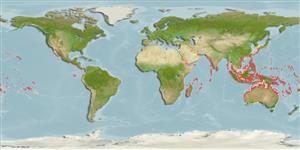>
Eupercaria/misc (Various families in series Eupercaria) >
Labridae (Wrasses) > Xyrichtyinae
Etymology: Iniistius: Latin, in = in + Greek, istion = sail.
More on author: Linnaeus.
Environment: milieu / climate zone / depth range / distribution range
Οικολογία
Θαλασσινό(ά) Υφαλόφιλο(α); εύρος βάθους 2 - 30 m (Ref. 90102). Tropical
Indo-Pacific: Red Sea and East Africa to the Pacific.
Μέγεθος / Βάρος / Age
Maturity: Lm ? range ? - ? cm
Max length : 25.0 cm TL αρσενικό/απροσδιόριστο; (Ref. 2334)
Short description
Κλείδες προσδιορισμού | Μορφολογία | Μορφομετρία
Ραχιαίες άκανθες (συνολικά) : 9; Μαλακές ραχιαίες ακτίνες (συνολικά) : 12; Εδρικές άκανθες: 3; Μαλακές εδρικές ακτίνες: 12 - 13.
Found over sandy bottoms of coastal areas and also in areas with some seagrass or algae. Ranges to a depth of over 18 m (Ref. 9710). Usually in large spread-out groups on upper slopes of sand and mud banks with males defending its section that has numerous females (Ref. 48636). Dives into sand to sleep safely at night or to hide when alarmed (Ref. 90102). When threatened, it dives head-first into sand; may take some time to emerge again. Feeds mainly on hard-shelled prey, including mollusks and crustaceans (Ref. 5374). Minimum depth taken from Ref. 9710.
Life cycle and mating behavior
Maturities | Αναπαραγωγή | Spawnings | Egg(s) | Fecundities | Προνύμφες
Pelagic spawner.
Randall, J.E., G.R. Allen and R.C. Steene, 1990. Fishes of the Great Barrier Reef and Coral Sea. University of Hawaii Press, Honolulu, Hawaii. 506 p. (Ref. 2334)
IUCN Red List Status (Ref. 130435)
Threat to humans
Harmless
Human uses
αλιεία: περιορισμένης εμπορικότητας; Ενυδρείο: Εμπορικό(ά)
Εργαλεία
Special reports
Download XML
Διαδικτυακές πηγές
Estimates based on models
Preferred temperature (Ref.
123201): 24.4 - 29.3, mean 28.3 °C (based on 3300 cells).
Phylogenetic diversity index (Ref.
82804): PD
50 = 0.5000 [Uniqueness, from 0.5 = low to 2.0 = high].
Bayesian length-weight: a=0.01023 (0.00397 - 0.02640), b=3.06 (2.84 - 3.28), in cm total length, based on LWR estimates for this (Sub)family-body shape (Ref.
93245).
Τροφικό Επίπεδο (Ref.
69278): 3.6 ±0.50 se; based on food items.
Ελαστικότητα (Ref.
120179): Μεσαίο(α), ελάχιστος χρόνος για διπλασιασμό πληθυσμού 1,4 - 4,4 έτη (Preliminary K or Fecundity.).
Fishing Vulnerability (Ref.
59153): Low vulnerability (15 of 100).
Nutrients (Ref.
124155): Calcium = 60.7 [37.1, 98.7] mg/100g; Iron = 0.619 [0.367, 1.115] mg/100g; Protein = 18.6 [15.7, 20.8] %; Omega3 = 0.146 [0.097, 0.220] g/100g; Selenium = 25.1 [15.8, 43.5] μg/100g; VitaminA = 124 [39, 440] μg/100g; Zinc = 1.45 [1.02, 2.23] mg/100g (wet weight);
